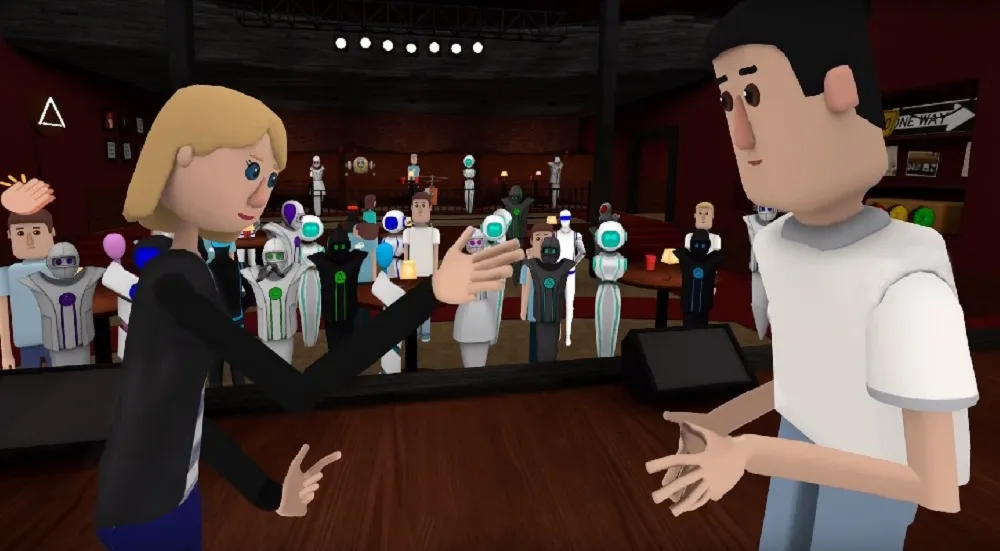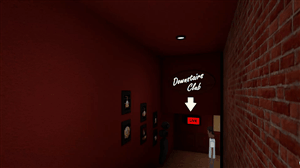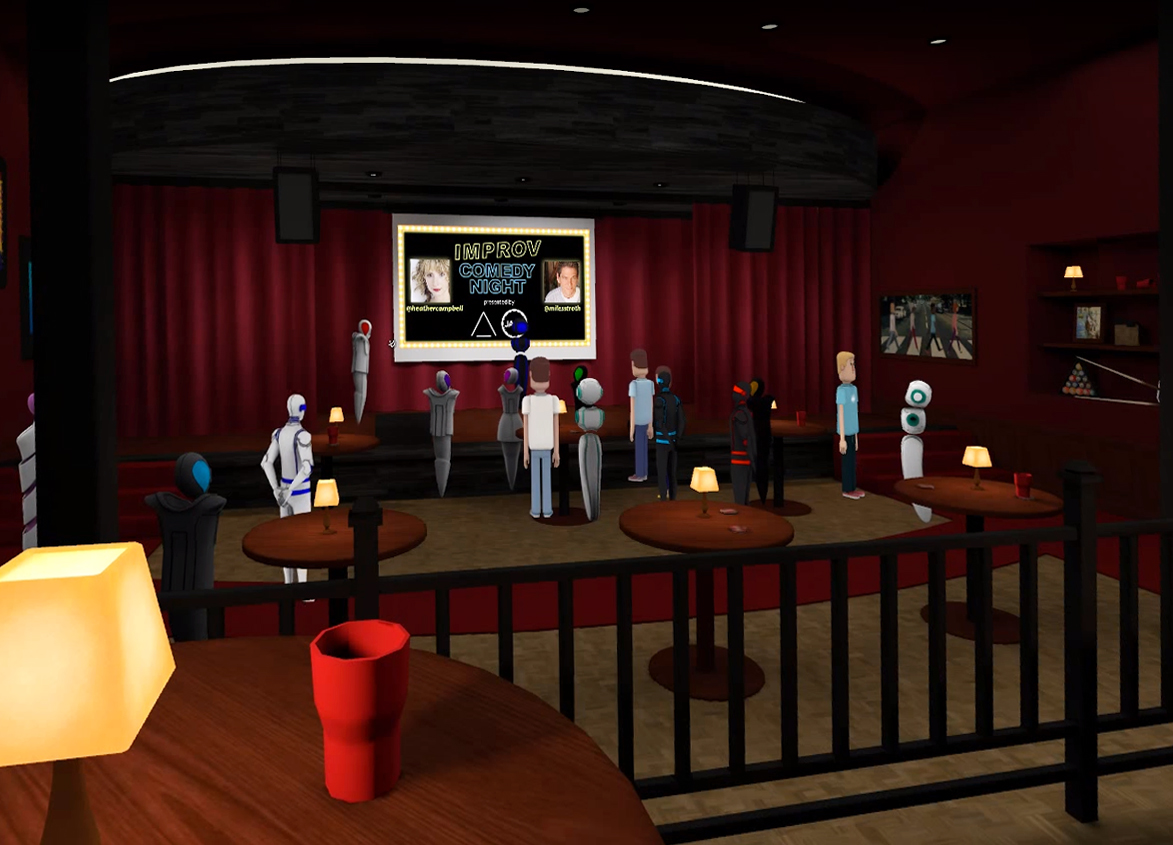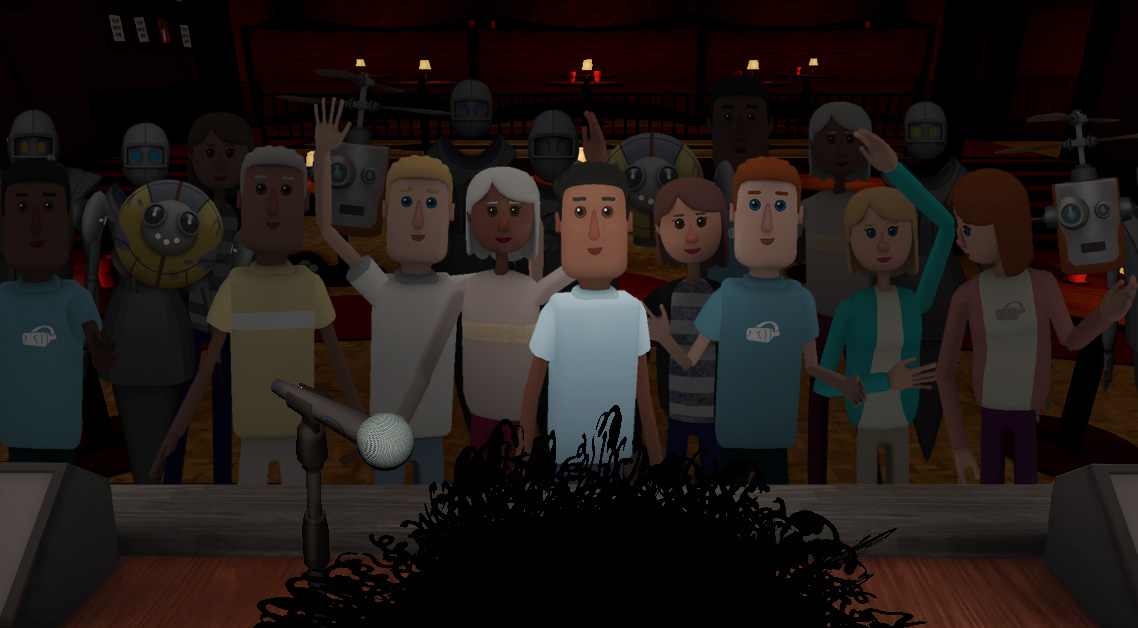The sleek highrise apartment is arguably the last place you’d expect to find an improv comedy act. The tall glass windows give way to a vague cityscape while a dozen or more individuals lounge around a sunken half-circle couch, the two performers standing in front of a comically oversized television with their names and Twitter handles displayed. They work their way through a bit about a doctor accusing his patient of having an illicit affair with a dermatologist. Upon discovering the strength of true love, the two performers hug it out, accidentally reenacting the Kali Ma scene from Indiana Jones as their arms phase into each other’s’ upper chest cavities.
https://www.youtube.com/watch?v=k2RfabiNBmg
Performance Art in a Virtual Space
It’s far from a macabre act, though. Performers Robert Chan and Adam McCabe are in virtual reality, wearing full motion capture suits. The audience is represented by mostly robot avatars, and since they’re connecting from various locations around the world, their laughter is filtering in through their own headsets’ microphones at just a hair past natural reaction time. AltspaceVR, a company focused on “social VR” experiences and business communications, is breaking new ground in the world of comedy, and open mic nights may never look the same.
“What we’ve found in test studies is that a great user experience in Altspace often begins with a laugh,” Eric Romo, founder and CEO of AltspaceVR said. “There’s something special about laughing with other people.”
It was a simple rationalization for a company built on fostering communities of people who lived nowhere near each other. Even in the relatively early stages of large-scale experiences, Romo says there’s something engaging about it all, even the rough bits.
“Something has to be pretty amazing to make you laugh by yourself, but we sort of joke and call this the ‘crappy comedy effect,’” Romo said, alluding to the idea of enjoying an awful film with friends who will engage in its inherent silliness. “That great psychological uplift that comes when the whole group is laughing, we just thought this is such an opportunity to do something in Altspace that you can’t do in another medium. You don’t watch YouTube together and all get on the phone and laugh, right?”
And there are certainly challenges (or just general awkwardness) to overcome for virtual comedy. Perhaps no one knows that better than the comedians themselves. A veteran of The Second City and Chicago Underground Comedy, Ever Mainard’s first experience with VR was one of Altspace’s comedy nights. Like most new adopters of VR, her misconceptions about the medium colored her first interactions, forcing her to learn the nature of interaction in the virtual world in a traditionally intimate experience. Instead of immediate reactions from the audience, laughter pops in a second later, heart emojis flutter above heads, and sometimes people just log out, blinking from existence.
“I think we all have the same sort of emotional intelligence, so I knew exactly once you addressed the sheer awkwardness and get that out of the room and get everybody on the same page, the energy is there,” Mainard said. “I knew there were still real people behind those avatars, so it was still really interactive.”
In its present state, the VR comedy scene certainly embraces that shared awkwardness. Erratic movements of performers’ avatars are drawn into an improv scene, accidental murmurs from the audience distract, and sometimes, in the absence of a proper “stage,” audience members just teleport to within inches of a performer’s face. While some of these issues are inevitable in audiences still cutting their teeth on their new VR toys, Romo and Altspace are working to address some of the more obvious shortcomings, like their new FrontRow development, which allows for cloning of a room across multiple states for a shared, front row experience.
“We like to acknowledge that we don’t know if this is going to be good until we try it,” Romo said. “I think as we started to realize there’s something psychologically – crowd-wise and performer-wise – that if you put them in an environment that feels more right, you start to have more of that emotional connection to the space.”
To that end, Altspace has built its own virtual comedy club, complete with dimly lit lounge tables, red curtains, photos of past performers adorning the wall, and a proper stage that sits just a foot or so above the floor. There’s even a sign saying “To Backstage – Performers Only,” which one presumably leads to a black hole of nothingness – or a green room; same thing.
One particularly good bit of news for fans of live comedy: The drunken heckler destined for a YouTube slam video is another item being considered. Altspace have devoted significant time to considering how dynamic audio influences a performance, so when that louder-than-usual audience member gives a shout, it will ideally feel like they’re coming from their actual position in the club, as opposed to all around you.
“People would chime and cheer, and if we stepped over one another, I felt people would let one another talk and then we could all laugh at that,” Mainard said. “It was interesting only because it was like talking at a group of people versus talking to someone. Everybody was on the same playing field.”
Revolutionizing Stand-Up Comedy
The innovations don’t stop at the physical, though. One of Altspace’s ultimate goals is to reshape how comedy fans think of the traditional club experience, both from an audience perspective and a hopeful performer’s. While most comedy clubs embed themselves into downtown districts of major cities, adding VR to the mix means that even the most rural of jokesters can throw their hat into a casual open mic night.
“I think folks in Los Angeles or New York have some great avenues to find local comedy places where they can do an open mic or be involved in their scene with some regularity,” Romo said. “Not necessarily everybody has that ability.”
Like the relatively democratized YouTube, Twitter, or Vine, these new platforms each gave way to a legion of new performers who managed to carve out their own followings. It likely won’t reach such a boiling point for VR comedy for some time (Altspace is one of few, if not the only company currently hosting such events with regularity, plus VR adoption rates are only just now hitting admirable levels), but the possibilities – as with all of VR – are endless.
“I think what really gets me excited about this is providing that opportunity for literally anybody in the world,” Romo said. “To be able to say ‘Yeah, there’s a cool open mic night and I live in wherever, some random spot in the middle of the United States, but I’m going to perform in front of a bunch of people and get a bunch of feedback on my routine.’ It’s a really exciting direction we’re taking because we often talk from the perspective of an audience member, but I think it’s equally true from the perspective of the performer.”
The lineup for Altspace’s comedy nights certainly aren’t hurting for decent name recognition. Comedian and musician Reggie Watts is actually scheduled for later today, along with regular rotations from Jash, a comedian collective led by the likes of Sarah Silverman and Michael Cera. You can even listen to us interview Ever Mainard in more detail on a prior episode of UploadVR’s Presence Podcast.
The prospect of VR comedy clubs can be a daunting one, even for those already well into the swing of all things virtual. It remains to be seen if Altspace can turn these projects into a for-profit wing of their business, if they even want to. Like all things VR, it’s a test of getting comedy enthusiasts in seats and headsets long enough to appreciate the novelty, and acknowledge the possibilities.
Hey, at least no one’s paying $8 for a cocktail.
—
Joseph Knoop is a freelance writer with work published at Game Informer, PC Gamer, Playboy, and other outlets. You can follow him on Twitter: @JosephKnoop.






























